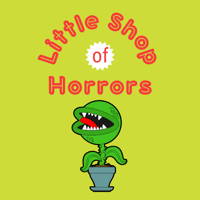
Overview
Synopsis
Little Shop of Horrors is a gleefully macabre sci-fi horror musical, powered by Alan Menken and Howard Ashman’s infectious 1960s-style pop, rock, and Motown score.
Seymour Krelborn, a shy and awkward assistant at a failing flower shop on Skid Row, stumbles upon a strange, exotic plant after a mysterious total eclipse of the sun. He names it “Audrey II” in honor of his kind-hearted co-worker and secret crush, Audrey. To his shock, the plant begins to speak—smooth, sassy, and soulful—and reveals a disturbing appetite for fresh human blood.
As Seymour’s small offerings help Audrey II grow to monstrous proportions, his life transforms. The shop thrives, the media takes notice, and romance seems possible. But the price of success is steep: the plant’s demands escalate from drops of blood to full human meals.
When Seymour discovers Audrey II’s alien origins and diabolical plan for world domination, he must decide whether to stop the plant—or become just another victim in its leafy path to conquest.
Show Information
Context
Little Shop of Horrors began its theatrical life on May 6, 1982, as a workshop production at the Players’ Art Theatre in New York. Just a few months later, on July 27, it officially opened Off-Broadway at the Orpheum Theatre in the East Village. Although the production received offers to move to a Broadway house, director Howard Ashman—who also wrote the show’s book and lyrics—insisted that the quirky, intimate nature of the musical was better suited to the Off-Broadway scene. His instincts
to read the context for Little Shop of Horrors and to unlock other amazing theatre resources!Plot
Prologue
An omnipotent voice describes a horrible threat to mankind that has appeared in the unlikeliest of places. Crystal, Ronnette, and Chiffon enter to warn the audience of the perils that await them at the local florist’s (“Little Shop of Horrors”).
Act One
The scene opens on Mushnik’s Skid Row Florists shop. At 10 a.m. sharp a crash is heard in the back room. Seymour attempts to assure Mushnik that he hasn’t broken anything. One hour later Audrey, Mushnik’s quirky blonde
to read the plot for Little Shop of Horrors and to unlock other amazing theatre resources!Characters
| Name | Part Size | Gender | Vocal Part |
|---|---|---|---|
|
Lead |
Male |
Tenor |
|
|
Lead |
Female |
Mezzo-Soprano |
|
|
Supporting |
Male |
Baritone |
|
|
Supporting |
Not Specified |
Silent |
|
|
Supporting |
Female |
Mezzo-Soprano |
|
|
Supporting |
Female |
Mezzo-Soprano |
|
|
Supporting |
Female |
Mezzo-Soprano |
|
|
Supporting |
Male |
Baritone |
|
|
Supporting |
Male |
Baritone |
|
|
Ensemble |
Either or Both |
|
Songs
Act One
Notes
In Act I of Little Shop of Horrors, meek floral shop assistant Seymour discovers a strange, talking plant he names Audrey II, which brings fame and business to the failing shop. As the plant grows, it demands human blood, forcing Seymour into a moral crisis that sets him on a dangerous path.
Act Two
Notes
In Act II of Little Shop of Horrors, Seymour’s success continues as Audrey II grows ever larger and more demanding, pushing him toward increasingly desperate and immoral acts. As the plant’s true, sinister nature is revealed, it ensnares Seymour, Audrey, and others, leading to a darkly comedic and tragic climax.
A song with an asterisk (*) before the title indicates a dance number.
Monologues
Scenes
Key Terms
A group of performers who comment on the action, originating in Ancient Greek theatre.
The clarity and articulation of speech by an actor or singer, critical for conveying emotion and meaning on stage.
A vocal music style with tight harmonies that appears in musical theatre portraying 1950s and 60s American pop culture.
A Faustian bargain is a deal in which a person sacrifices moral integrity, values, or even their soul in exchange for power, knowledge, success, or another form of personal gain. The term comes from the German legend of Faust, who sold his soul to the devil for unlimited knowledge and pleasure. In theatre and literature, this concept often explores themes of temptation, ambition, and the consequences of greed. An example is Seymour in Little Shop of Horrors, who agrees to feed Audrey II in exchange for fame and love.
A group in Ancient Greek theatre that commented on the action, represented the public, and provided narrative insight.
A recurring element, such as a symbol, image, or phrase, that reinforces a play’s themes. Motifs help unify the structure of a work and deepen its symbolic meaning.
Motown refers to a style of popular music that emerged in Detroit in the 1960s, blending elements of soul, rhythm and blues, and pop. Known for its polished sound and infectious rhythms, Motown launched the careers of legendary artists such as Diana Ross, Stevie Wonder, and Marvin Gaye. In theatre and film, Motown often symbolizes cultural pride, crossover success, and the power of Black artistry.
An introductory speech or scene that sets up the context or themes of a play. Prologues are commonly used in classical drama to prepare the audience for what follows.
A genre of popular music that has influenced musical theatre, especially in shows highlighting African-American culture.
Videos
Quizzes
Themes, Symbols & Motifs
Themes
Ambition and Moral Compromise
to read about the themes, symbols and motifs from Little Shop of Horrors and to unlock other amazing theatre resources!Quote Analysis
1. “Feed me, Seymour!” – Audrey II
This is the
to read our analysis of select quotes from Little Shop of Horrors and to unlock other amazing theatre resources!
